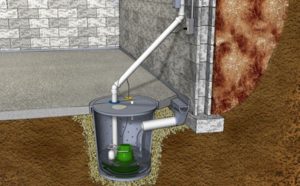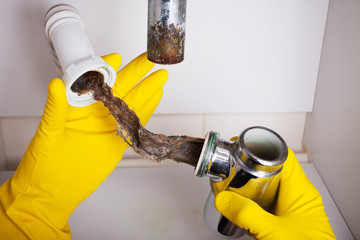Consistent sump pump maintenance helps prevent major issues and costly repairs. It is important to regularly inspect and clean your sump pit, float, check valve, and discharge line.
Occasionally, sump pumps encounter problems that are beyond your ability to troubleshoot and fix yourself. When this happens, call On Point Plumbing & Heating.
A sump pump requires a lot of electricity to function. So, like any electrical device, it can experience problems when the power goes out or a circuit breaker trips. If your sump pump isn’t running at all, it’s probably time for a professional to come out and inspect it. Having a working sump pump is critical for protecting your home from flooding and water damage.
A common reason for a sump pump not turning on is a stuck switch. This is a problem often found in cheaper models and occurs when the float switch gets tangled or jammed in the system. It’s important to inspect the sump pit regularly to make sure no objects are obstructing the switch.
Another reason your sump pump may not be turning on is that it is drawing too much power for the fuse or circuit breaker to handle. This can cause the fuse or circuit breaker to blow, which will then prevent your sump pump from working properly. If you notice this problem, it’s best to have a professional check out the sump pump and determine whether or not it needs a new fuse or a larger circuit breaker.
If your sump pump is running all the time, it can burn out quickly. It’s also not good for your basement or your electric bill. To test your sump pump, try manually lifting the float switch to see if it turns on. You can also check the float switch brackets to make sure they aren’t clogged or broken. You should also check the discharge line to ensure it isn’t clogged or blocked by debris.
If your sump pump isn’t draining, there’s likely a clog or blockage in the discharge pipe. This can be caused by debris, dirt, or roots in the discharge line. A faulty check valve can also prevent your sump pump from removing water. Inspect the check valve for proper installation, referencing the arrows on it to make sure they are pointed in the right direction. If you can’t find the source of the clog, a licensed plumber can take a look at your sump pit and install or replace the check valve for you.
Clogs
Clogs are one of the most common reasons sump pumps fail. A clogged sump pump can cause water to build up in your basement, leaving you with a flooded house. You can prevent these problems by regularly checking and cleaning your sump pump.
Start by making sure the sump pump has power. If the power is on but the pump won’t turn on, this could mean there’s a problem with the float switch or impeller.
If the float switch isn’t working, it could be jammed or filled with dirt. You can check this by manually lifting the switch to see if it works or not. If it’s still jammed, you will need to take a look at the float switch itself to fix it.
Another common problem is a clogged discharge pipe. This is the pipe that drains the water from your sump pump out of your home. The best way to prevent this is by cleaning it regularly and removing any debris from the area around it.
The discharge line can also get clogged with dirt, rodents, rocks, or other objects. These can get stuck in the discharge line or even the grate that covers it. If the discharge line is clogged, your sump will be forced to work harder to drain the water from your basement and can overheat.
You should also check the float switch and the drain pipe for clogs. If you find that the pump is clogged, you should remove the lid from the sump pit or basin and scoop out any sand or debris until it’s clean. You should then add about 5 gallons of water to the basin and watch as the float switches on and off to see if the pump is able to pump efficiently.
A clogged motor is a clear sign that the sump pump needs to be replaced. This can be caused by a damaged check valve, a faulty discharge line, or an issue with the pump’s motor. You should contact Ballard Plumbing to handle this issue before it causes serious damage to your sump pump.
Corrosion
Corrosion can be caused by several things, including stress corrosion cracking, intergranular corrosion, and crevice corrosion. This is most common in pumps with welded joints, and it can lead to the failure of internal components. If you notice a corroded sump pump, it’s time to call in a professional to replace it before further damage occurs.
A humming noise is normal for a sump pump, but if it starts making rattling or grinding sounds, you may have a problem with the motor. In some cases, the noises can come from debris that is stuck inside the impeller, which looks like a propeller and is located in the center of the pump. In other cases, the noises can come from clanging noises caused by the vibrations of the discharge pipes as the pump is operating.
The best way to prevent this type of issue is to regularly clear out the inlet screen and drain line. Also, be sure to check the discharge line annually for blockages or leaks.
In the event that you do need to replace your sump pump, make sure you disconnect power from it before working on it. It is also a good idea to disconnect the pump from the piping and remove it from the basin so that you can more thoroughly inspect and clean the entire unit.
Sump pumps are a great way to protect your home from flooding, but they need regular maintenance to ensure that they work properly. If you notice any signs that your sump pump isn’t functioning correctly, call us for a quick and affordable repair. We can diagnose the problem quickly and help you find the right sump pump solution for your home.
A sump pump is a crucial investment for homeowners, so be sure to schedule regular maintenance visits. These maintenance visits can help prevent issues and catch problems before they become serious, saving you from the costly inconvenience of a flooded basement. We offer a wide range of sump pump repair services, as well as plumbing and waterproofing. Contact us today to schedule an appointment!
Damage
Sump pump parts can wear out with time, causing them to stop working properly. These problems can lead to serious water damage and expensive repairs, so it’s important to check your sump pump regularly for these issues. A professional can perform more in-depth inspections and maintenance tasks than the average homeowner, preventing these problems before they happen.
If your sump pump won’t turn on, check to see if it has power by plugging it in and checking the float switch to see if it is stuck. It’s also a good idea to unplug the pump, remove it from the basin, and inspect it for signs of rust or corrosion. Also, be sure to clean the inlet screen and drain out the pump check valve (the one-way valve on your discharge line that helps prevent water backflow) every year.
The most common mechanical issue with a sump pump is the float switch, which can get stuck in its position or become clogged by debris. The float rises when the sump pump activates, and it turns off when the water level has fallen to a certain point. If the float switch is stuck or clogged, you’ll need to replace it.
Other mechanical problems with a sump pump can include problems with the impeller blades, which may be worn out or broken. If the impeller blades are worn out, they can cause blockages in the discharge lines that are not easily fixed with a rag or a plunger. If the impeller is broken or damaged, it needs to be replaced by a professional.
A sump pump should be tested annually before the “wet season” in early spring. A test involves pouring five gallons of water into the pump to verify that it works as expected. A sump pump that doesn’t turn on at the correct time can lead to flooding in your home and costly water damage. Also, sump pumps that are installed incorrectly can cause serious problems down the road. A professional can ensure that your sump pump is positioned correctly to protect your home from floods.


